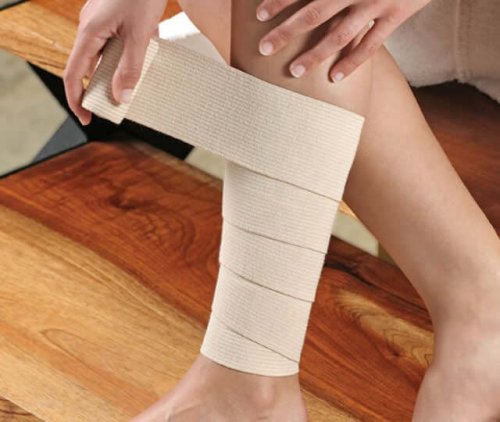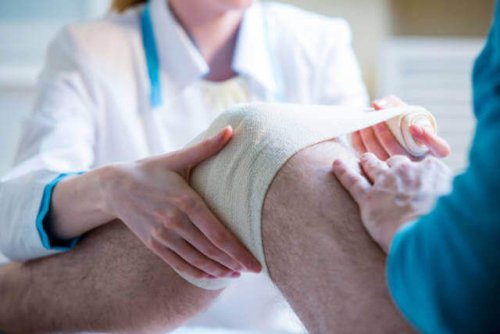Dressings and Bandages, a User's Guide


Written and verified by the doctor Leonardo Biolatto
Applying dressings and bandages is a procedure for wrapping an injured part of the body to immobilize or protect it. There are many materials for this purpose such as gauze, canvas, etc. The injury might be muscular, such as contracture, or a bleeding wound.
People have been using bandages for thousands of years. Some people believe that Hippocrates, a doctor from ancient Greece and the father of modern medicine, was the first person to place a bandage for the treatment of a venous ulcer. However, others claim that older civilizations, such as the Egyptians, already used them for various medicinal treatments. Currently, most of us use them to treat our injuries and bruises.
In today’s article, we’ll tell you everything you need to know about bandages.
What’s the purpose of dressings and bandages?

As you know, there are various types of bandages and multiple uses for them. People often use them either for protecting wounds, preventing infection, or to stop bleeding. However, we may also use them to limit the movement of a limb or a joint or a sprain. In the same way, they help affix splints and support some part of the body.
Bandages can be useful for venous circulation. In fact, this is particularly useful in people with leg edemas. Also, they help keep dressings and medication in place and can also stop hemorrhages.
The function of bandages
Overall, we can say that bandages have three main purposes:
- Containing: These are used for certain cures that require holding a dressing or medication in place.
- Compression: These are helpful to firmly squeeze a limb (when the purpose is to stop bleeding, for example).
- Corrective: These immobilize a limb so it can repair, as is the case with a dislocation.
You may be interested: Heal a Sprained Ankle with Complementary Remedies
What types of bandages are there?

Bandages come in all shapes and forms depending on their purpose:
- Circular bandages are for holding a dressing on one arm or one leg. To do so the doctor wraps them around an entire limb.
- Then there’s the spiral bandage. These help hold splints in place to immobilize a hand, an arm or a leg. In this case, medical professionals use elastic bandages placed in a spiral fashion.
- The spica bandage is very similar to the spiral bandage. Here, doctors apply successive strips of material to the body and the first part of a limb, or the hand and a finger. Thus, they overlap slightly.
- Also, there’s the figure-eight bandage. Doctors usually place them on the joints. To do so, a doctor applies a bandage alternately to two parts, usually two segments of a limb above and below the joint. They do so in such a way that the turns form a figure-eight. This is a specific bandage used for the treatment of fractures of the clavicle. There is a special form of figure-eight bandage used in the treatment of clavicle fractures. Here, the figure-eight forms on a patient’s back and keeps the back straight by pulling the shoulders back.
- Finally, there’s the recurrent bandage. This is for bandaging the head or an amputated limb. To do so, the cover an entire area from front to back with a bandage. Then, they go around in circles to affix it horizontally.
You might like: Treatment of Soft Tissue Injuries
Do dressings and bandages pose any health risk?
Like any other treatment or technique, bandages can also result in complications. This is especially true when people use them without knowing what they’re doing and don’t follow proper procedures and indications.
For example, compartment syndrome could occur if you excessively tighten a bandage. This occurs when oxygenated blood cannot reach all parts due to the compression. Thus, the parts that remain isolated become cold and bluish. Also, there may be bedsores or ulcers due to the use of overly rigid bandages. Similarly, it’s common for the skin to macerate when the bandage covers a moist area.
Conclusion
Bandages are a very useful technique for treating all sorts of injuries, from simple wounds to bone fractures. However, doctors only recommend them when done by a professional who knows the procedure and can properly follow the instructions to do so.
All cited sources were thoroughly reviewed by our team to ensure their quality, reliability, currency, and validity. The bibliography of this article was considered reliable and of academic or scientific accuracy.
- PortalesMedicos.com (Firm). (n.d.). Atención de enfermería en los vendajes funcionales. PortalesMedicos.com. Retrieved from https://www.revista-portalesmedicos.com/revista-medica/atencion-de-enfermeria-en-los-vendajes-funcionales/
- Soriano Compañ, A. (2010). Vendajes. Club Universitario. Retrieved from https://books.google.com.ar/books?id=Omg5xZWvajsC&pg=PA5&dq=vendajes&hl=es&sa=X&ei=o6PyU5j9HcjvoATOvILYDg&redir_esc=y#v=onepage&q=vendajes&f=false
- Tipos de vendajes. (n.d.). Retrieved from http://www.sld.cu/galerias/pdf/sitios/urgencia/6vendajes.pdf
- Vendajes — Enfermería Práctica. (n.d.). Retrieved October 8, 2019, from https://enfermeriapractica.com/procedimientos/vendajes
This text is provided for informational purposes only and does not replace consultation with a professional. If in doubt, consult your specialist.








